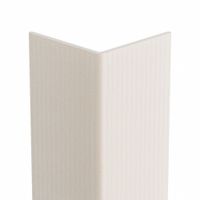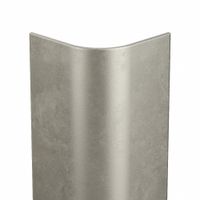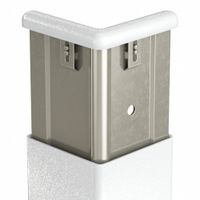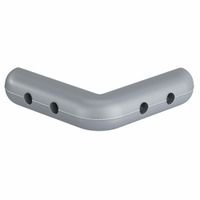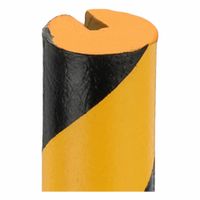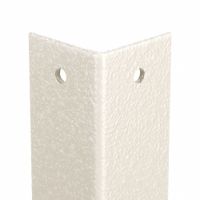Call +(254) 703 030 000 / 751 483 999 / 721 704 777
- Home
- Hardware
- Corner Guards Wall Protection Handrails
- Corner Guards Edge Guards Bumpers
.....Read More
Frequently Asked Questions
What are corner guards and how do they work?
Corner guards are protective devices designed to shield the edges and corners of walls, furniture, or equipment from damage. They are commonly used in high-traffic areas such as hospitals, schools, offices, and homes to prevent wear and tear caused by collisions, impacts, or abrasions.
Corner guards are typically made from materials like plastic, rubber, stainless steel, or aluminum, chosen based on the level of protection required and aesthetic preferences. They come in various shapes, sizes, and finishes to suit different environments and design needs.
The primary function of corner guards is to absorb and deflect impact, thereby minimizing damage to both the corner and the object or person that comes into contact with it. This is particularly important in settings where carts, wheelchairs, or other equipment are frequently moved, as these can easily chip or dent unprotected corners.
Installation of corner guards is straightforward and can be done using adhesive backing, screws, or nails, depending on the material and surface. Some corner guards are designed to be removable, allowing for easy replacement or repositioning.
In addition to their protective role, corner guards can also enhance safety by reducing the risk of injury from sharp or protruding corners. This is especially beneficial in environments with children or elderly individuals who may be more prone to accidents.
Overall, corner guards are a cost-effective solution for maintaining the integrity and appearance of structures and furnishings, while also contributing to a safer environment.
How do I install self-adhesive corner guards?
To install self-adhesive corner guards, follow these steps:
1. **Select the Right Corner Guards**: Choose corner guards that match your decor and are suitable for the type of surface you are applying them to.
2. **Clean the Surface**: Use a mild detergent or cleaning solution to thoroughly clean the corners where the guards will be applied. Ensure the surface is free from dust, grease, and moisture. Allow it to dry completely.
3. **Measure and Mark**: Measure the height of the corner where you want to install the guard. Use a pencil to lightly mark the starting and ending points on the wall to ensure proper alignment.
4. **Prepare the Corner Guard**: Remove the corner guard from its packaging. If necessary, cut it to the desired length using a utility knife or scissors.
5. **Peel Off the Adhesive Backing**: Carefully peel off the protective backing from the adhesive strip on the corner guard. Avoid touching the adhesive to maintain its stickiness.
6. **Align and Apply**: Position the corner guard at the top mark on the wall. Align it carefully with the corner, ensuring it is straight. Press the guard firmly against the wall, starting from the top and working your way down. Apply even pressure along the entire length to ensure a secure bond.
7. **Secure the Edges**: Run your fingers along the edges of the corner guard to ensure it is fully adhered to the wall. Pay special attention to the top and bottom edges.
8. **Final Check**: Inspect the installation to ensure the guard is straight and securely attached. Make any necessary adjustments immediately.
9. **Allow to Set**: Let the adhesive cure for the recommended time specified by the manufacturer before applying any stress or pressure to the corner guard.
By following these steps, you can effectively install self-adhesive corner guards to protect your walls and enhance safety.
What is the difference between adhesive-ready and screw-in corner guards?
Adhesive-ready corner guards and screw-in corner guards are two types of protective solutions used to safeguard wall corners from damage. The primary difference between them lies in their installation methods and applications.
Adhesive-ready corner guards are designed for easy installation using adhesive backing. They typically come with a pre-applied adhesive strip or require a separate adhesive application. This type of corner guard is ideal for situations where a quick, non-invasive installation is needed. They are suitable for smooth surfaces and are often used in residential settings or areas where minimal wall damage is desired. Adhesive-ready guards are less permanent and can be removed with minimal residue, making them a good choice for temporary installations or rented spaces.
Screw-in corner guards, on the other hand, require screws for installation. This method provides a more secure and durable attachment, making them suitable for high-traffic or industrial environments where stronger protection is necessary. Screw-in guards are typically made of more robust materials like metal or heavy-duty plastic, offering enhanced durability. The installation process is more involved, requiring tools and potentially causing minor wall damage due to the screw holes. However, they provide a long-lasting solution and are less likely to shift or detach over time.
In summary, the choice between adhesive-ready and screw-in corner guards depends on the specific needs of the environment. Adhesive-ready guards offer ease of installation and removal, suitable for less demanding applications, while screw-in guards provide a more permanent and durable solution for high-impact areas.
How do bullnose corner guards differ from standard corner guards?
Bullnose corner guards and standard corner guards primarily differ in their shape and design, which affects their functionality and aesthetic appeal.
Bullnose corner guards feature a rounded, convex shape that resembles the rounded end of a bull's nose. This design provides a smooth, curved surface that is particularly effective in environments where safety is a priority, such as in schools, hospitals, and homes with children or elderly individuals. The rounded edges help to minimize the risk of injury upon impact, as there are no sharp angles that could cause harm. Additionally, the bullnose design can offer a more aesthetically pleasing look, blending seamlessly with rounded architectural features and providing a softer appearance.
In contrast, standard corner guards typically have a straight, angular design with a 90-degree angle, covering the corner edges directly. These are often used in commercial and industrial settings where the primary concern is protecting walls and corners from damage caused by equipment, carts, or heavy foot traffic. The straight edges of standard corner guards provide robust protection against impacts and are often made from durable materials like metal, plastic, or rubber to withstand frequent contact.
Both types of corner guards can be made from various materials, including PVC, stainless steel, aluminum, or rubber, and can be customized in terms of color and size to suit specific needs. However, the choice between bullnose and standard corner guards often depends on the specific requirements of the environment, balancing considerations of safety, aesthetics, and durability.
What materials are corner guards typically made from?
Corner guards are typically made from a variety of materials, each chosen for specific properties that suit different environments and applications. Common materials include:
1. **PVC (Polyvinyl Chloride):** Widely used due to its affordability, durability, and ease of installation. PVC corner guards are often used in residential and commercial settings where moderate protection is needed.
2. **Rubber:** Known for its flexibility and impact absorption, rubber corner guards are ideal for areas with high traffic or where heavy equipment is used, such as warehouses and parking garages.
3. **Stainless Steel:** Offers high durability and resistance to corrosion, making it suitable for industrial environments, hospitals, and kitchens. Stainless steel corner guards provide a sleek, modern look while offering robust protection.
4. **Aluminum:** Lightweight and resistant to rust, aluminum corner guards are used in both indoor and outdoor settings. They provide a good balance between strength and weight.
5. **Wood:** Often used in residential or office settings for aesthetic purposes. Wooden corner guards can be stained or painted to match interior decor but offer less impact resistance compared to metal or rubber.
6. **Acrylic or Polycarbonate:** These materials are chosen for their transparency and impact resistance. They are often used in settings where maintaining the visibility of the underlying surface is important, such as in museums or galleries.
7. **Brass:** Used for decorative purposes, brass corner guards add a touch of elegance and are often found in upscale environments. They offer moderate protection and are resistant to tarnishing.
Each material offers distinct advantages, and the choice depends on factors such as the level of protection required, aesthetic preferences, environmental conditions, and budget constraints.
Are corner guards suitable for outdoor use?
Yes, corner guards can be suitable for outdoor use, but their effectiveness and longevity depend on the material and design. Outdoor environments expose corner guards to various elements such as UV rays, moisture, temperature fluctuations, and physical impacts. Therefore, selecting the right type of corner guard is crucial.
1. **Material**:
- **Metal**: Stainless steel and aluminum corner guards are highly durable and resistant to rust and corrosion, making them ideal for outdoor use. They can withstand harsh weather conditions and provide long-lasting protection.
- **Rubber**: Rubber corner guards are flexible and can absorb impacts, making them suitable for areas with frequent physical contact. However, they may degrade over time due to UV exposure.
- **Plastic**: High-density polyethylene (HDPE) or polycarbonate corner guards are lightweight and resistant to weathering. They are often UV-stabilized to prevent degradation from sunlight.
2. **Design**:
- Corner guards designed for outdoor use often have additional features such as UV inhibitors, weather-resistant coatings, or drainage channels to prevent water accumulation.
- Some designs include reflective strips for visibility, enhancing safety in low-light conditions.
3. **Installation**:
- Proper installation is crucial for outdoor corner guards to ensure they remain secure and effective. Adhesive-backed guards may not hold up well in extreme temperatures or moisture, so mechanical fastening methods like screws or bolts are recommended.
4. **Maintenance**:
- Regular maintenance, such as cleaning and inspection, can extend the life of outdoor corner guards. This helps in identifying any wear or damage early, allowing for timely repairs or replacements.
In summary, while corner guards can be suitable for outdoor use, choosing the appropriate material and design, along with proper installation and maintenance, is essential for optimal performance and durability.
How do I choose the right corner guard for my needs?
To choose the right corner guard, consider the following factors:
1. **Material**: Select a material based on the environment and level of protection needed. Options include:
- **Plastic (PVC)**: Affordable, easy to install, and suitable for low-impact areas.
- **Rubber**: Offers flexibility and impact absorption, ideal for areas with frequent contact.
- **Metal (Stainless Steel or Aluminum)**: Provides high durability and is suitable for industrial or high-traffic areas.
- **Wood**: Aesthetic choice for residential or office settings, offering moderate protection.
2. **Size and Dimensions**: Measure the corners you need to protect. Ensure the guard covers the entire corner and extends slightly beyond for optimal protection.
3. **Installation Method**: Choose based on ease and permanence:
- **Adhesive**: Easy to install and remove, suitable for temporary needs.
- **Screw-mounted**: Offers a more permanent solution, ideal for high-impact areas.
- **Magnetic**: Allows for easy repositioning, suitable for metal surfaces.
4. **Design and Aesthetics**: Match the corner guard with the existing decor. Consider color, finish, and style to ensure it complements the environment.
5. **Safety Standards**: Ensure the corner guard meets any relevant safety standards, especially in environments like hospitals or schools.
6. **Budget**: Balance cost with quality and durability. Higher initial investment in durable materials can lead to long-term savings.
7. **Brand and Reviews**: Research brands and read customer reviews to gauge reliability and performance.
By evaluating these factors, you can select a corner guard that effectively meets your protection needs while fitting seamlessly into your environment.
